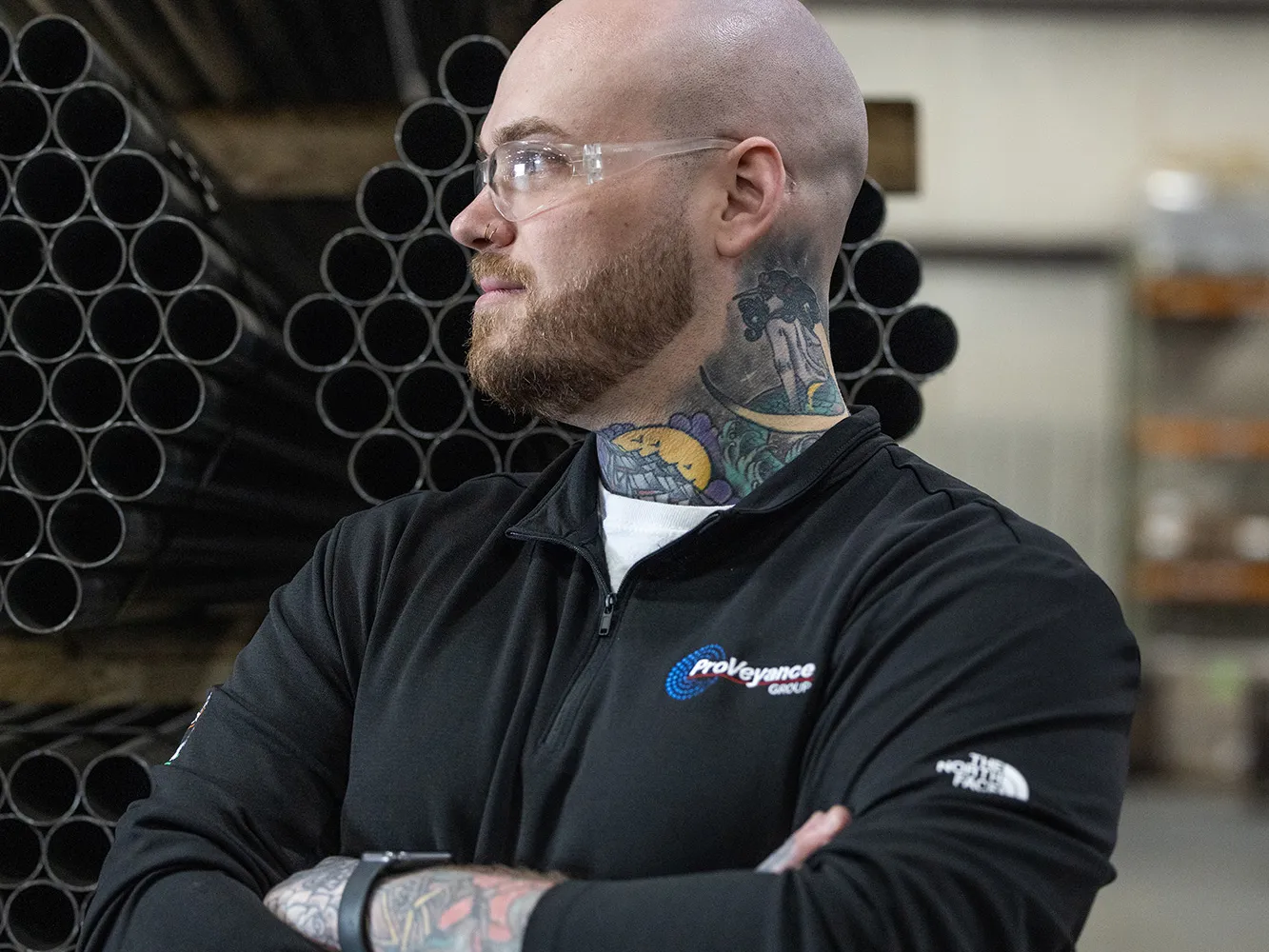Expert in electric vehicles answers alumni questions
Alum and Assistant Professor Stephanie Stockar discusses where we stand, and where we’re headed, with electric vehicles.

In constant pursuit of energy efficiency, Stephanie Stockar ’12 MS, ’13 PhD runs the COST Lab and is affiliated with Ohio State’s Center for Automotive Research. (Photo by Logan Wallace)
Electric vehicles have their champions and their skeptics. While they may be the key to a more sustainable future, they still have some catching up to do with traditional cars. And that’s where Ohio State researchers like Stephanie Stockar ’12 MS, ’13 PhD come in, seeking to close the gap.
Stockar is an assistant professor in Ohio State’s Department of Mechanical and Aerospace Engineering and director of the Control and Optimization for Sustainable Technology (COST) Lab. Her work is aimed at optimizing next-generation vehicles, unlocking the intricacies of what will make hybrid, electric and autonomous vehicles run smoother and longer. She focuses on EV range estimation and traffic systems, building on larger-scale mobility systems for the cities of tomorrow. And she recently answered questions from alumni.
-
Why is such a small car so overpriced? What’s the profit margin? — Walt Holbrook ’72
The higher cost of EVs, even smaller ones, is due to expensive battery materials and ongoing investments in R&D. Profit margins vary but are often lower than those of traditional vehicles as automakers scale up production. As battery technology improves and economies of scale are achieved, EV prices are expected to decrease, making them more affordable over time.
-
How many years will it take for EVs to become as reliable and friendly as cars powered by gasoline? — Martin Saperstein ’78 MA, ’81 PhD
EVs are already more reliable in many ways, with fewer moving parts and lower maintenance requirements than internal combustion engine-based vehicles. Within the next five to 10 years, EVs are expected to match or surpass gasoline cars in terms of convenience, as charging infrastructure expands and technology matures.
-
What is the advantage of electric vs. combustion when EVs still use fossil fuels? — Melanie Babiak Biche ’85
Even when powered by fossil-fuel-based grids, EVs have key advantages. First, emissions are centralized at power plants rather than dispersed across millions of vehicles. This makes it easier to monitor, regulate and implement technologies like carbon capture and renewable energy at a few facilities rather than at the vehicle level. Second, EVs are inherently more energy-efficient than combustion vehicles, converting a higher percentage of stored energy into motion rather than wasting it as heat.
-
When will drivers be able to recharge in the time it takes to fill up your car with gas, so you can drive across country and not get stuck? — Sheila Rakusin Ronis ’72, ’74 MA, ’76 PhD
Ultra-fast chargers, such as 350 kW systems, already exist and can recharge some EVs to 80% in about 15–20 minutes. However, achieving gasolinelike refueling speeds will require further advancements in battery materials, safety and infrastructure upgrades to handle higher power levels. Widespread availability of such speeds may take another five to 10 years, depending on technological breakthroughs and the pace of infrastructure deployment.
-
I saw that Ford is going to standardize their models to use the Tesla charger. Does this seem to be an industry trend? — Douglas E. Gingrich ’74
Ford’s adoption of Tesla’s North American Charging Standard (NACS) signals a shift toward industry standardization. This trend simplifies the charging experience for consumers and reduces compatibility issues, making EV adoption easier. With other automakers, like GM and Rivian, also announcing plans to adopt NACS, the unified charging standard should accelerate infrastructure development and consumer confidence.
-
What relationship, if any, is being used with power companies to ensure the power grid can handle more electric vehicles? — Richard Clum ’07
Utilities are partnering with automakers, policymakers and infrastructure developers to ensure grid readiness for EV adoption. These collaborations focus on grid modernization, integrating renewable energy and implementing demand-response programs to balance energy use. Additionally, vehicle-to-grid technology is being explored to allow EVs to provide backup power to the grid during peak demand.
-
What new innovations are on the horizon? — Ruth Rogers Bauman ’77
Innovations include adoption of new materials and improvement in the manufacturing processes of lithium-ion batteries. These promise faster charging, improved safety and durability, and the potential for significant cost reductions as they become commercially mature. Wireless or inductive charging is another development, enabling EVs to charge without physical plugs. This holds significant potential for urban and fleet charging, with many deployments already happening or planned.
Advanced driver-assistance systems (ADAS) enhanced by vehicle-to-vehicle (V2V), vehicle-to-infrastructure (V2I) communications and AI are also evolving, offering features like adaptive cruise control, energy-efficient route planning and autonomous driving. Finally, vehicle-to-grid systems are being developed, allowing EVs to serve as mobile power storage, stabilizing the grid and providing backup power for homes and businesses.
-
What are the environmental negatives of electric vehicles (I’ve heard the production of batteries is resource consuming) and do the positives outweigh them? — Hilary Amos Mayclin ’01
Battery production is resource-intensive, requiring materials like lithium, cobalt and nickel, which involve energy-intensive mining and sometimes ethical concerns. However, EVs compensate for this during their lifetime by emitting significantly less CO₂ than combustion vehicles.
Moreover, it’s important to recognize that gasoline refinement and oil extraction are far from environmentally friendly practices. Processes like drilling, transporting and refining oil carry significant environmental risks, including catastrophic events like oil spills, which cause widespread ecological damage. Recycling initiatives and advancements in alternative, less resource-intensive battery chemistries are reducing the environmental impact of EVs. In the long run, the positives outweigh the negatives, especially as grids transition to renewables and battery technology becomes more sustainable.
-
Why buy an electric vehicle when the technology, especially the battery technology, has not yet matured? What are the chances that when the technology is matured, existing electric vehicles will quickly lose their resale value? — Scott Wilkins ’72
Most automakers provide extensive warranties on batteries, mitigating risks for buyers. Additionally, software updates can enhance functionality over time, ensuring today’s EVs remain valuable. The resale market for EVs is also growing, driven by demand for sustainable vehicles. While technological advancements may cause some depreciation, EVs are expected to retain value due to their operational cost savings and strong demand. Battery recycling and repurposing industries will also extend the usefulness of older EVs. The secondary market is growing, reflecting sustained interest in used EVs, especially for entry-level buyers.
-
What kind of car do you drive? — Ohio State Alumni Magazine staff
OK, so this is funny. I currently drive a 2012 Ford Focus Hatchback, and I absolutely love it. It’s so practical and has great gas mileage. The trunk space is incredible—it’s perfect for trips to IKEA and for our dog’s travel crate. Everything fits surprisingly well, and who doesn’t love a good game of Tetris?
That said, my next car will be electric. Right now, most of my commute to work is by bike or foot, but even for my weekend activities, an EV would make perfect sense. We are building a garage at home, and as part of the project, we are installing a Level 2 charger, even though we don’t have an EV (yet). We are getting ready for the switch.
Beyond trunk space, changing cars is also an environmental decision. Manufacturing a new car (electric or not) comes with its own environmental footprint. Extending the life of a well-functioning car can sometimes be the more sustainable choice.
The future of batteries
In a Now at Ohio State podcast, Buckeyes Stephanie Stockar ’12 MS, ’13 PhD, Professor of Practice Shawn Midlam-Mohler ’01 MS, ’05 PhD and Professor Marcello Canova discuss how they are researching batteries to help us achieve a more sustainable society.



